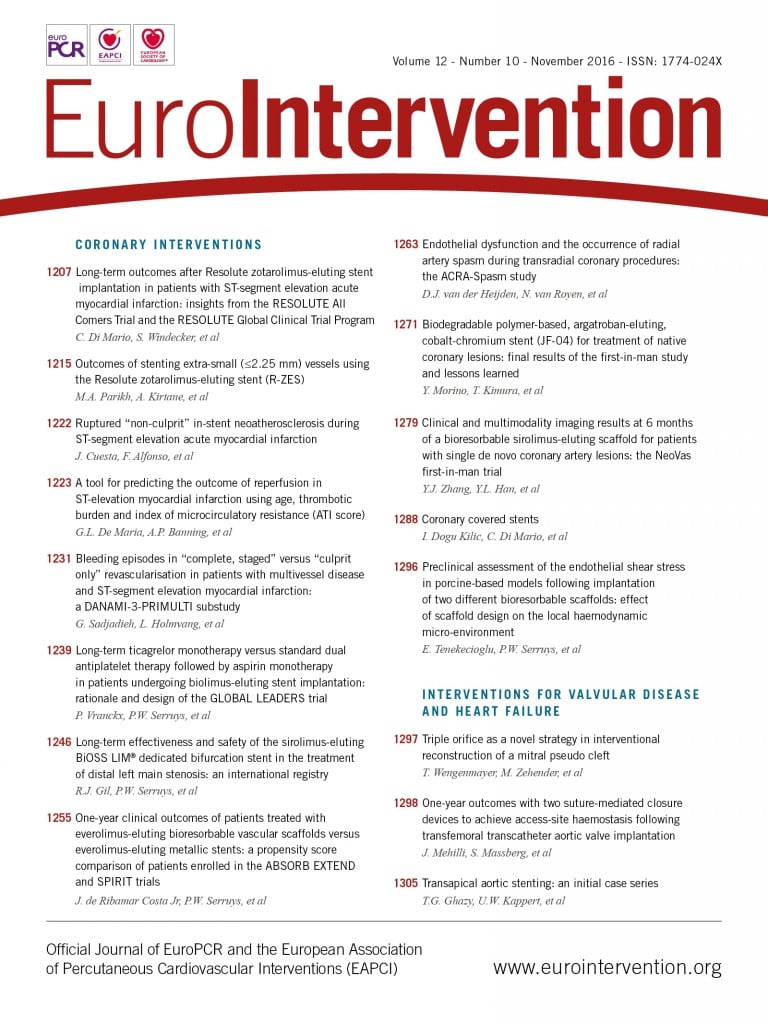
Over the last 12 months EuroIntervention received 1,155 original papers from investigators worldwide. Due to space limitation, only 170 could be published. Consequently, only circa 15% of submitted papers could be accepted, and many high-quality manuscripts had to be declined on the basis of priority. The process of selecting those manuscripts that can be published is an arduous one. After verification of initial quality check parameters by the editorial support staff, either the Editor-in-Chief or one of the Deputy Editors first reviews the paper. At this stage, the initial task is to assess whether the article can add to existing knowledge, if it reads well and makes sense, and whether the authors have delivered a clear message. A certain proportion of manuscripts will be declined upfront, as the Editor makes a judgement that, even if deficiencies identified in the review process can be addressed, the paper would not be able to achieve priority sufficient for publication. This is an important step, as it means that authors have the opportunity to try to place their work elsewhere as quickly as possible, without the time lost in an ultimately unsuccessful review process.
Papers that pass the first step of review are then typically assigned to an Associate Editor with expertise in the area of the manuscript, who will select peer reviewers and co-ordinate the review of the manuscript. Once the reports of the reviewers have been obtained, the paper is then presented and the reviews actively discussed in the Thursday afternoon editorial board meeting. After this, a final decision is reached and communicated to the authors.
The peer review process owes much to the voluntary endeavours of peer reviewers who give of their time without remuneration and without immediate tangible benefit to themselves, aside perhaps from the early insight afforded into the efforts of fellow researchers and colleagues. For these efforts we are truly grateful. Indeed, without them the scientific process would falter. Moreover, a journal’s reputation depends to a large extent on the quality of its peer review.
At present, in common with many other journals in cardiovascular medicine, the peer review process at EuroIntervention is single-blind. This means that reviewers’ names remain unknown to the authors but authors’ names and affiliations are known to the reviewers. Alternative models exist and are used in scholarly publishing, although there is no clear consensus on which model works best1. Fully open review – where neither party is blinded – is in operation at some journals, such as the British Medical Journal2. While proponents argue that increased transparency may produce reviewers who are more courteous and constructive, opponents are concerned that it may promote less critical commentary3. Double-blind review is also in use. It has recently been trialled at Nature main journal and might protect against biases related to author or institutional affiliation, both negative and positive4. However, studies investigating the potential advantage of this approach are inconclusive and some are concerned about harm. For the time being then, single-blind review seems the favoured approach for most journals.
So what are the characteristics of a high-quality review? Broadly speaking, there are three essential elements. First, a critical appraisal of the paper often begins with a brief summary of the key methodological aspects and main observations of interest. Although this is not absolutely necessary, it shows in what light the reviewer has digested and understood the main messages of the investigators and provides a sound basis for more detailed critique. Limitations are then highlighted by specific references to the text of the paper (with page and/or line numbers) or to prior literature. Review comments and issues to be addressed should ideally be sorted numerically, in order of decreasing priority. Many reviewers divide their comments into major and minor issues, which can also assist the editor and authors when reading the review. Vague criticisms are unhelpful to editors and authors alike. Similarly, uncritical plaudits are unlikely to be useful for improving the paper. While it is important to be polite and respectful of the work of the authors, critical comments are generally more valuable than praise. It is usually easier for the editor to quash critical comments from the reviewer than it is to overturn favourable remarks.
Second, a high-quality review will interpret the findings of the authors in the context of already existing publications and/or presentations. A short commentary on this aspect with listing of important similar publications on this topic is invaluable and is a hallmark of a high-quality review. This typically entails a literature search by the reviewer to fully assess the novelty of the findings. While experts will know well the most important publications in the area under question, the proliferation of scientific publications in cardiovascular medicine nowadays makes it almost impossible to stay fully up to date by journal reading alone, and reviewing an article often provides a useful impetus for a brief updated search of PubMed when review comments are being drafted. Although reproduction of prior observations is of undoubted value, the reality is that novel observations will often have higher priority for publication. In addition, when applicable, a brief check of study registration websites is indispensable. Nowadays, prospective study registration provides an important foundation stone for scientific reports, helping to ensure that study hypotheses are transparently presented in advance and endeavouring to reduce the problems of publication bias5. To serve a useful function, it is vitally important that these sites are cross-checked at the time of peer review by both reviewers and editors alike.
Third, the reviewer should make a summary recommendation to the handling editor in the “comments to the editor” section of the submission site. These remarks are not visible to the authors and usually incorporate a brief comment on originality and on the scientific reliability of the observations. Where major deficiencies exist, the reviewer should indicate the extent to which these flaws might be remedied in any manuscript revision. Echoing observations once made by Tony DeMaria, it continues to surprise how often these comments are omitted6. Moreover, direct reproduction of “comments to the authors” is not helpful, as the editor will have access to both sets of comments.
Peer review is an essential part of the scientific process. It is in many respects an altruistic pursuit, founded on effort, dedication and integrity. Nevertheless, although it is often presented as unblemished and sometimes even as almost sacred, we realise of course that it is a human endeavour beset by normal human biases and failings. It is our job – and indeed privilege as editors – to try to assess and mitigate these risks when interpreting the comments of reviewers. For the tireless work of our reviewers in serving the journal and our community we are extremely grateful. For the confidence of our authors in entrusting us with their hard-worked scientific papers we are equally thankful.

